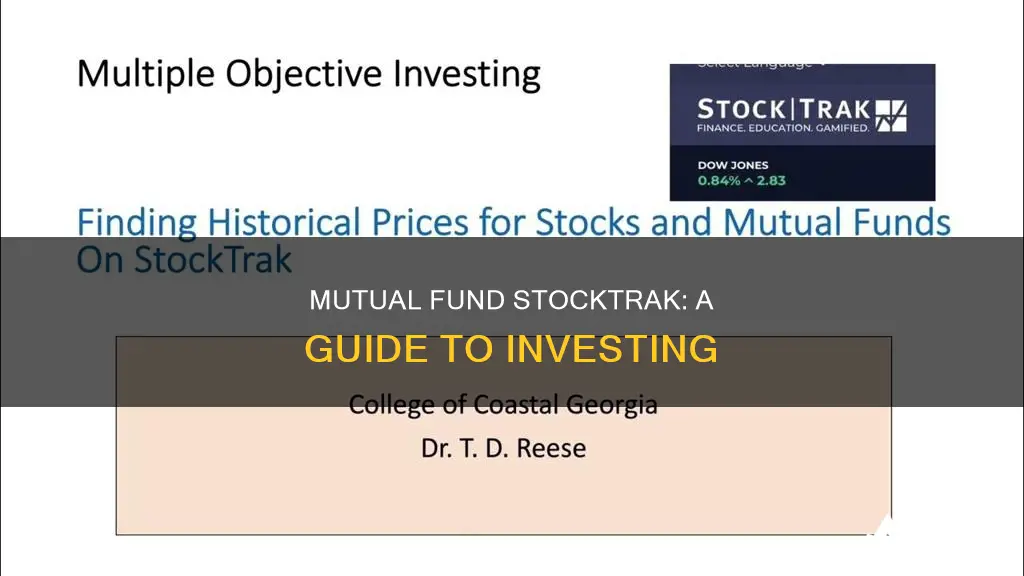
StockTrak is a portfolio simulation tool for universities to help students get familiar with real market data, buying and selling securities, and managing a portfolio in a controlled environment. Mutual funds are a way to buy into a wide range of stocks, bonds, money markets, or other securities all at once. They are professionally managed, so investors are buying a piece of a larger portfolio. Mutual funds come in three types: Open Ended, Closed Ended, and Unit Investment Trusts. When investing in mutual funds on StockTrak, there are a few things to keep in mind, such as the fact that you are buying a dollar amount, not a number of shares, and that mutual fund orders execute when the markets are closed.
What You'll Learn
- Mutual funds are a way to buy into a wide range of stocks, bonds, money markets or other securities
- Mutual funds are professionally managed and investors buy a piece of a larger portfolio
- There are three types of mutual funds: open-ended, closed-ended and unit investment trusts
- Mutual funds are sold in shares, like stocks, but there may or may not be a limit to the number of shares outstanding
- Mutual funds can be a great way to diversify your portfolio

Mutual funds are a way to buy into a wide range of stocks, bonds, money markets or other securities
Mutual funds are a way to buy into a wide range of stocks, bonds, money markets, or other securities. They are professionally managed, allowing investors to buy into a larger portfolio. Mutual funds are also known as open-end funds, meaning that investors can buy and sell shares daily based on the net asset value (NAV) of their shares.
The core concept of a mutual fund is that it pools money from many investors to purchase a bundle of securities. All contributors to the fund are given shares in proportion to their contributions, and they receive returns based on the performance of the underlying security. Mutual funds are sold in shares, and it is common to own fractions of a share.
There are several different types of mutual funds, but they typically fall into three categories: Open-Ended, Closed-Ended, and Unit Investment Trusts. Open-ended funds have no limit to the number of shares, while closed-ended funds have a fixed number of shares that can be traded on an exchange. Unit Investment Trusts are less common and have a limited lifespan.
Mutual funds can be an easy way to diversify an investment portfolio, and they have historically been an important part of retirement planning. They also pass through dividends to their shareholders. However, the professional management of mutual funds comes at a price, and fees can add up quickly, especially if the fund is underperforming. Additionally, investors have no control over the holdings of a mutual fund.
To invest in a mutual fund, you will need to follow these steps:
- Check with your employer if they offer mutual fund products, as these may have additional benefits.
- Ensure you have a brokerage account with enough deposits to buy mutual fund shares.
- Identify mutual funds that match your investment goals and preferences for risk, returns, fees, and minimum investments.
- Determine how much you want to invest and submit your trade. You can also set up automatic recurring investments.
- Periodically check on the fund's performance and make adjustments as needed.
- When you are ready to close your position, enter a sell order on your platform.
Vanguard Funds: Where to Invest and Why
You may want to see also

Mutual funds are professionally managed and investors buy a piece of a larger portfolio
Mutual funds are a way to buy into a wide range of stocks, bonds, money markets, or other securities all at once. They are professionally managed, so investors are buying a piece of a larger portfolio. Mutual funds are a pool of money contributed by many different investors that is used to purchase a bundle of securities. All contributors to the fund are given shares in proportion to how much they contributed, and they receive returns based on the performance of the underlying security.
Mutual funds are sold in shares, just like stocks. However, unlike stocks, there may or may not be a limit to the number of shares outstanding at any given time, depending on the type of mutual fund. It is common to own "fractions" of a share of a mutual fund.
Mutual funds typically fall into one of three categories: Open-Ended, Closed-Ended, and Unit Investment Trusts. Open-ended funds have no limit to the number of shares that can exist at any given time. Investors can also cash out any day they want by selling their shares in the fund at the market price for that day. Closed-ended funds, on the other hand, have a fixed number of shares and can trade on an exchange. These funds are still professionally managed, but the total amount invested is determined only once at the Initial Public Offering. Unit Investment Trusts are less common and are also closed-ended. These funds have a limited lifespan and are not professionally managed.
Mutual funds can be a great way to diversify your portfolio. Since there are many different types, it is usually possible to find a selection to complement your portfolio. They have historically been an important part of retirement planning as they do not require as much attention as a portfolio of stocks that you actively pick, buy, and sell.
Mutual funds also "pass through" dividends to their shareholders. If a stock owned by the mutual fund pays a dividend, it is paid directly to the mutual fund shareholders. However, it is important to note that mutual funds generally charge a fee based on the initial capital invested, which can add up quickly, especially if the fund is underperforming.
Retirement Mutual Funds: Choosing the Right Investment for Your Future
You may want to see also

There are three types of mutual funds: open-ended, closed-ended and unit investment trusts
Mutual funds are a way to buy into a wide range of stocks, bonds, money markets, or other securities all at once. They are professionally managed, so you are buying a piece of a larger portfolio. Mutual funds typically fall into one of three categories: open-ended, closed-ended, and unit investment trusts.
Open-Ended Mutual Funds
Open-ended funds have no limit to the number of shares that can exist at any given time. Investors are issued shares based on how much money they have contributed, which is then used to buy underlying securities. Investors can cash out any day they want by selling their shares in the fund at the market price for that day. This also means that investors cannot day trade mutual funds; since the actual distribution of assets is managed by professional portfolio managers, the actual value of each share is not known until the end of the day. Investors can only buy and sell their shares from the fund managers themselves, not trade their shares on the open market.
Closed-Ended Mutual Funds
Closed-ended funds have a fixed number of shares and can trade on exchange (similar to an ETF). These funds are still professionally managed, but the total amount invested is determined only once, at the Initial Public Offering (IPO).
Unit Investment Trusts
Unit Investment Trusts are much less common than the other types of funds and are also closed-ended. These funds are unique in that they have a limited lifespan; they are issued once, but the fund eventually expires and all investors are paid out based on their investment and the return of the underlying assets. Unlike other types of funds, these are not professionally managed; the holdings are determined at the IPO and remain fixed while the fund is active. However, investors can redeem their shares from the fund managers at any time, or even sell shares on the open market (although this is very rare).
Fidelity's High Initial Investment Strategy for Money Market Funds
You may want to see also

Mutual funds are sold in shares, like stocks, but there may or may not be a limit to the number of shares outstanding
Mutual funds are a way to buy into a wide range of stocks, bonds, money markets, or other securities all at once. They are professionally managed, so you are buying a piece of a larger portfolio. Mutual funds are sold in shares, just like stocks. However, unlike stocks, there may or may not be a limit to the number of shares outstanding at any given time. This depends on the type of mutual fund.
There are three main types of mutual funds: open-ended, closed-ended, and unit investment trusts. Open-ended funds have no limit to the number of shares that can exist at any given time. Investors can cash out any day they want by selling their shares in the fund at the market price for that day. Because the actual distribution of assets is managed by professional portfolio managers, the value of each share is not known until the end of the day, and investors cannot day trade mutual funds.
Closed-ended funds, on the other hand, have a fixed number of shares and can trade on an exchange, similar to an ETF. These funds are still professionally managed, but the total amount invested is determined only once, at the Initial Public Offering.
Unit investment trusts are less common than the other types of funds and are also closed-ended. These funds have a limited lifespan and eventually "expire," paying out all investors based on their investment and the return of the underlying assets. Unit investment trusts are not professionally managed; the holdings are determined at the Initial Public Offering and remain fixed while the fund is active. However, investors can redeem their shares from the fund managers at any time or even sell shares on the open market, although this is rare.
When buying mutual fund shares, it is important to remember that you are buying a dollar amount, not a number of shares. The number of shares you receive will depend on the net asset value (NAV) of the fund, which is calculated at the end of each trading day. Mutual funds typically allow investors to purchase fractional shares.
Mutual funds can be purchased directly from the financial company that manages the fund, or through an online discount brokerage or a full-service broker. Many funds require a minimum contribution, often between $1,000 and $10,000, but some are higher, and some funds do not set any minimum. It is important to research different funds and choose one that aligns with your investment goals and risk tolerance.
Mutual Funds: Philippines' Smart Investment Choice
You may want to see also

Mutual funds can be a great way to diversify your portfolio
There are several types of mutual funds, but the core concept is always the same. The fund is a pool of money contributed by many different investors, which is used to purchase a bundle of securities. All contributors to the fund are given shares in proportion to how much they contributed, and they receive returns based on the performance of the underlying security.
One of the advantages of mutual funds is that they can be an easy way to diversify your portfolio. Since there are many different types of mutual funds, it's usually possible to find a selection that will complement your portfolio. For example, you could choose a sector-specific fund or one based on other factors. Mutual funds have historically been an important part of retirement planning because they do not require as much attention as a portfolio of stocks that you actively pick, buy, and sell.
However, there are also some disadvantages to mutual funds. The biggest disadvantage is the cost. Mutual funds generally charge a fee based on the initial capital invested, which can add up over time, especially if the fund is underperforming. Additionally, you have no option to customise the holdings of a mutual fund. You're stuck with what the fund manager chooses.
Overall, mutual funds can be a great way to diversify your portfolio, but it's important to consider the pros and cons before investing.
Retirement Planning: Target Mutual Funds for Future Security
You may want to see also
Frequently asked questions
Mutual funds are a way to buy into a wide range of stocks, bonds, money markets, or other securities all at once. They are professionally managed, so you are buying a piece of a larger portfolio.
Mutual funds can be an easy way to diversify your portfolio. Since there are many different types, it is usually possible to find a selection to complement your portfolio. They have historically been an important part of retirement planning as they do not require as much attention as a portfolio of stocks that you actively pick, buy and sell. Mutual funds also pass through dividends to their shareholders.
The biggest disadvantage is the cost. The professional management of the fund comes at a price and mutual funds generally charge a fee based on the initial capital invested. This can add up quickly, especially if the fund is underperforming. There is also no option to customise the holdings of a mutual fund.







